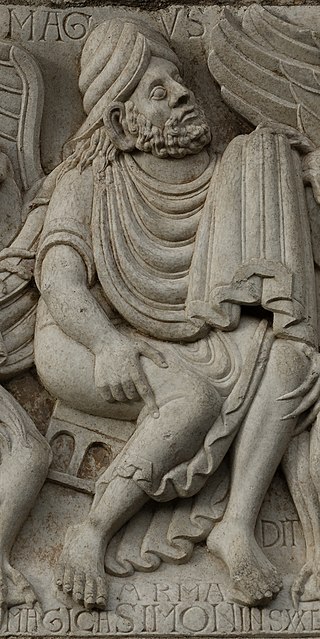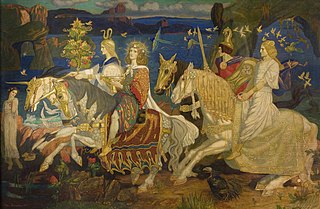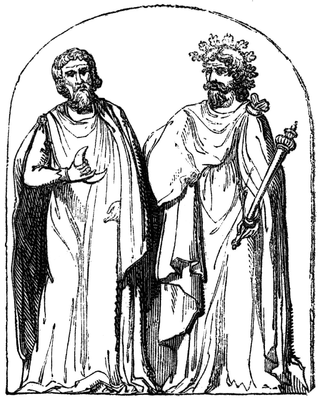Related Research Articles

Simon Magus, also known as Simon the Sorcerer or Simon the Magician, was a religious figure whose confrontation with Peter is recorded in the Acts of the Apostles. The act of simony, or paying for position, is named after Simon, who tried to buy his way into the power of the Apostles.

The TuathaDé Danann, also known by the earlier name Tuath Dé, are a supernatural race in Irish mythology. Many of them are thought to represent deities of pre-Christian Gaelic Ireland.
Conn Cétchathach, or Conn of the Hundred Battles, son of Fedlimid Rechtmar, was a semi-legendary High King of Ireland who is the ancestor of the Connachta, and through his descendant Niall Noígiallach, the Uí Néill dynasties, which dominated Ireland in the early Middle Ages.
Cormac mac Airt, also known as Cormac ua Cuinn or Cormac Ulfada, was, according to medieval Irish legend and historical tradition, a High King of Ireland. He is probably the most famous of the ancient High Kings, and may have been an authentic historical figure, although many legends have attached themselves to him, and his reign is variously dated as early as the 2nd century and as late as the 4th. He is said to have ruled from Tara, the seat of the High Kings of Ireland, for forty years, and under his rule, Tara flourished. He is credited for building many of the monuments at the Hill of Tara such as the Banqueting Hall, Cormac's house, and Gráinne's Enclosure, named after his daughter. He was famous for his wise, true, and generous judgments. In the Annals of Clonmacnoise, translated in 1627, he is described as:
"absolutely the best king that ever reigned in Ireland before himself...wise learned, valiant and mild, not given causelessly to be bloody as many of his ancestors were, he reigned majestically and magnificently".

In Irish mythology, the Badb (Old Irish, pronounced [ˈbaðβ]), or in Modern Irish Badhbh —also meaning "crow"—is a war goddess who takes the form of a crow, and is thus sometimes known as Badb Catha. She is known to cause fear and confusion among soldiers to move the tide of battle to her favoured side. Badb may also appear prior to a battle to foreshadow the extent of the carnage to come, or to predict the death of a notable person. She would sometimes do this through wailing cries, leading to comparisons with the bean-sídhe (banshee).

The Mythological Cycle is a conventional grouping within Irish mythology. It consists of tales and poems about the god-like Tuatha Dé Danann, who are based on Ireland's pagan deities, and other mythical races such as the Fomorians and Fir Bolg. It is one of the four main story 'cycles' of early Irish myth and legend, along with the Ulster Cycle, the Fianna Cycle and the Cycles of the Kings. The name "Mythological Cycle" seems to have gained currency with Arbois de Jubainville c. 1881–1883. James MacKillop says the term is now "somewhat awkward", and John T. Koch notes it is "potentially misleading, in that the narratives in question represent only a small part of extant Irish mythology". He prefers T Ó Cathasaigh's name, Cycle of the Gods. Important works in the cycle are the Lebor Gabála Érenn, the Cath Maige Tuired, the Aided Chlainne Lir and Tochmarc Étaíne.
In Irish mythology Tír na nÓg or Tír na hÓige is one of the names for the Celtic Otherworld, or perhaps for a part of it. Tír na nÓg is best known from the tale of Oisín and Niamh.
Tlachtga was a powerful druidess in Irish mythology and the red-haired daughter of the arch-druid Mug Ruith. She accompanied him on his world travels, learning his magical secrets and discovering sacred stones in Italy. Tlachtga's name was attached to the Hill of Ward in County Meath, which was the site of prominent festivals in her honour in the Middle Ages.
Dugan or Duggan is an Irish surname derived from Ó Dubhagáinn.

Cormac mac Cuilennáin was an Irish bishop and the king of Munster from 902 until his death at the Battle of Bellaghmoon. He was killed in Leinster.
The stories of the rogue sorcerer Simon Magus and his consort Helen, which showcased the early battles between religion and magic, have often captured the imagination of artists and writers.
Muirgius mac Tommaltaig was a King of Connacht from the Uí Briúin branch of the Connachta. He was the great-grandson of Indrechtach mac Muiredaig Muillethan, a previous king. The death of his father Tommaltach mac Murgail is recorded in the annals where he is called king of Mag nAi. Muirgius was of the Síl Muiredaig sept of the Uí Briúin. He reigned from 792 to 815.
Fiachu Muillethan or Fiachu Fer Da Liach, son of Éogan Mór, was a legendary king belonging to the Deirgtine, the proto-historical ancestors of the Eóganachta dynasties of Munster. He is known primarily from the saga Forbhais Droma Dámhgháire, in which he is assisted by the famous Mug Ruith, who repels an invasion of his kingdom by Cormac mac Airt. The sons of Fiachu Muillethan were Ailill Flann Mór and Ailill Flann Bec.
The Expulsion of the Déisi is a medieval Irish narrative of the Cycles of the Kings. It dates approximately to the 8th century, but survives only in manuscripts of a much later date. It describes the fictional history of the Déisi, a group that had gained political power in parts of Ireland during the Early Middle Ages. Part of the text's purpose is to provide the kings of the Déisi – historically the descendants of unlanded vassals to other tribes – with a mythical noble origin as the heirs to a dynasty expelled from Tara.

Knocklong is a small village situated in County Limerick, Ireland, located on the main Limerick to Mitchelstown to Cork road. The population was 256 at the 2016 census.
The Mairtine were an important people of late prehistoric Munster, Ireland who by early historical times appear to have completely vanished from the Irish political landscape. They are notable for their former capital, Medón Mairtine, becoming the chief church of the later Eóganachta, namely Emly.

A druid was a member of the high-ranking priestly class in ancient Celtic cultures. Druids were religious leaders as well as legal authorities, adjudicators, lorekeepers, medical professionals and political advisors. Druids left no written accounts. While they were reported to have been literate, they are believed to have been prevented by doctrine from recording their knowledge in written form. Their beliefs and practices are attested in some detail by their contemporaries from other cultures, such as the Romans and the Greeks.

Echtra Cormaic or Echtra Cormaic i Tir Tairngiri is a tale in Irish mythology which recounts the journey of the high-king Cormac mac Airt to the Land of Promise resided by the sea-god Manannán mac Lir.
References
- ↑ Ross, Anne (2004). Druids: Preachers of Immortality. Stroud, United Kingdom: History Press. ISBN 9780750952484 . Retrieved 2 July 2022.
- ↑ Classen, Albrecht (2017). Magic and Magicians in the Middle Ages and the Early Modern Time: The Occult in Pre-Modern Sciences, Medicine, Literature, Religion, and Astrology. Germany: De Gruyter. ISBN 9783110556520 . Retrieved 2 July 2022.
- ↑ "Revue celtique". Paris. 19 April 1870. Retrieved 19 April 2018– via Internet Archive.
- ↑ "RootsWeb.com Home Page". www.rootsweb.ancestry.com. Retrieved 19 April 2018.
- ↑ Labbacallee wedge tomb's folklore section.